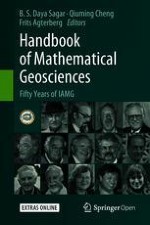Open Access 2018 | Open Access | Buch

Handbook of Mathematical Geosciences
Fifty Years of IAMG
herausgegeben von: Prof. B.S. Daya Sagar, Qiuming Cheng, Prof. Dr. Frits Agterberg
Open Access 2018 | Open Access | Buch

herausgegeben von: Prof. B.S. Daya Sagar, Qiuming Cheng, Prof. Dr. Frits Agterberg
This Open Access handbook published at the IAMG's 50th anniversary, presents a compilation of invited path-breaking research contributions by award-winning geoscientists who have been instrumental in shaping the IAMG. It contains 45 chapters that are categorized broadly into five parts (i) theory, (ii) general applications, (iii) exploration and resource estimation, (iv) reviews, and (v) reminiscences covering related topics like mathematical geosciences, mathematical morphology, geostatistics, fractals and multifractals, spatial statistics, multipoint geostatistics, compositional data analysis, informatics, geocomputation, numerical methods, and chaos theory in the geosciences.